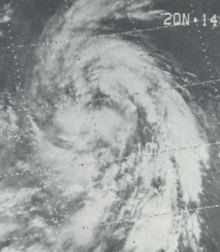 Satellite image of Bess on October 8 displaying dual centers of circulation | |
| Meteorological history | |
|---|---|
| Formed | October 8, 1974 |
| Dissipated | October 14, 1974 |
| Typhoon | |
| 10-minute sustained (JMA) | |
| Lowest pressure | 975 hPa (mbar); 28.79 inHg |
| Category 1-equivalent typhoon | |
| 1-minute sustained (SSHWS/JTWC) | |
| Highest winds | 120 km/h (75 mph) |
| Overall effects | |
| Fatalities | 32 total |
| Missing | 3 |
| Damage | $9.2 million (1974 USD) |
| Areas affected | Philippines, Hong Kong, Hainan Island, northern Vietnam |
| IBTrACS | |
Part of the 1974 Pacific typhoon season | |
Typhoon Bess, known in the Philippines as Typhoon Susang, was responsible for the disappearance of a United States Air Force weather reconnaissance aircraft. Developing out of a poorly organized system on October 8 to the east of the Philippines, Bess featured two centers of circulation. Initially the southern low was monitored; however, a low to the north soon became the dominant center. Tracking generally west-northwestward, the storm gradually intensified before striking northern Luzon as a minimal typhoon on October 11. Temporary weakening took place due to interaction with land. After moving back over water the following morning, Bess regained typhoon intensity. This was short-lived though, as conditions surrounding the cyclone soon caused it to weaken. Now moving due west, the weakening storm eventually struck Hainan Island as a tropical storm on October 12 before diminishing to a tropical depression. The depression briefly moved back over water before dissipating in northern Vietnam on October 14.
Bess produced heavy rains throughout the Philippines, especially in Luzon where 782.3 mm (30.80 in) was measured in Baguio. These rains triggered extensive flooding and landslides that killed 26 people and left 3 others missing. Many homes were destroyed and damage amounted to $9.2 million (1974 USD). On October 12, a reconnaissance plane, with a crew of six, investigating the periphery of the storm went missing. It is presumed that the entire crew was lost when the aircraft crashed off the coast of Luzon. Though the center remained offshore, strong winds and high tides also impacted Hong Kong, causing minor flooding.